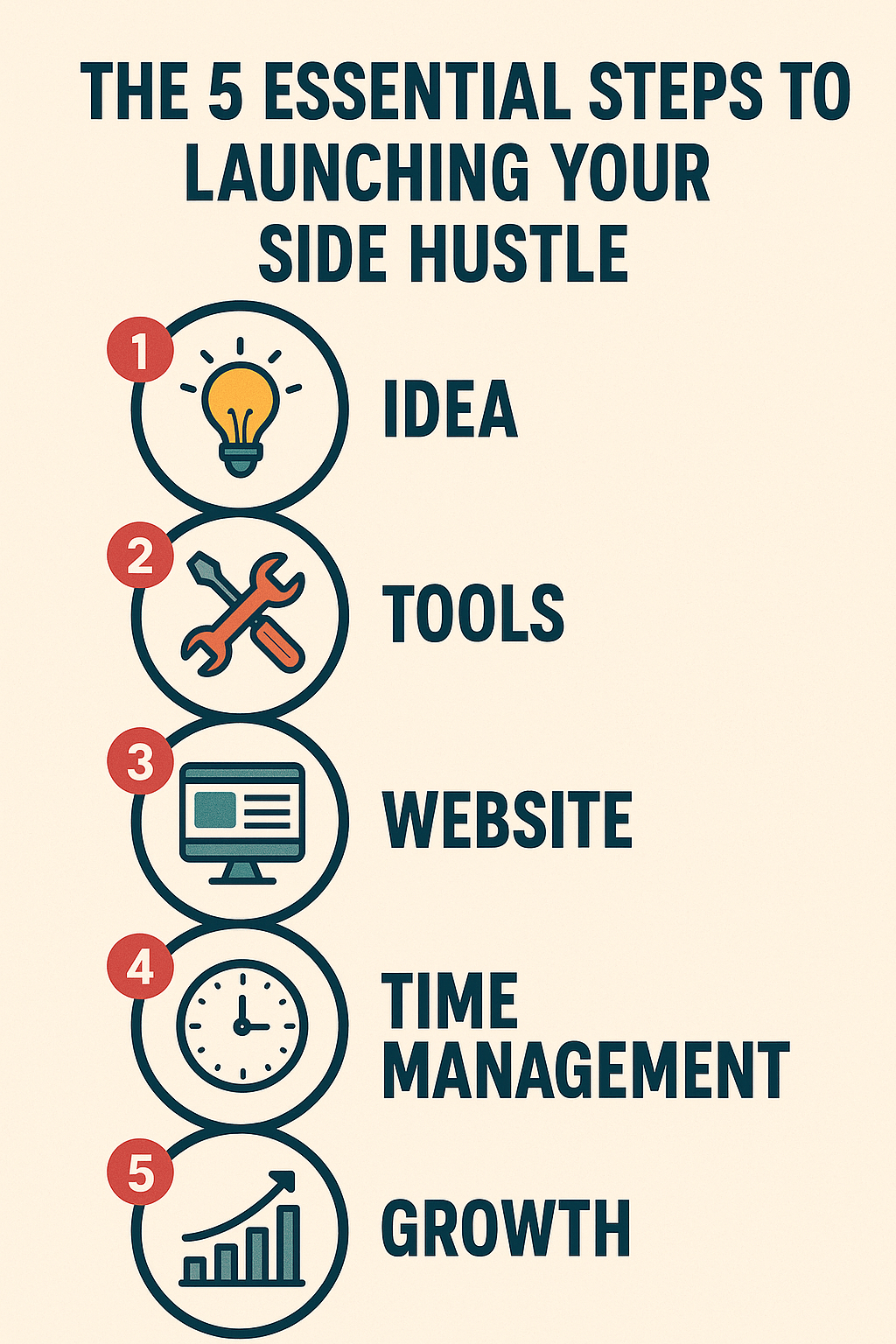Side hustles are the new black. Whether you're saving for a dream trip, padding your emergency fund, or testing out a business idea, a side hustle can give you freedom, flexibility, and a taste of what it’s like to be your own boss. But let's be real: juggling a 9-to-5 and your passion project can also leave you totally fried if you’re not strategic.
This guide is here to help you start smart, grow intentionally, and build a side hustle that lights you up — not one that burns you out.
Table of Contents
- Why Start a Side Hustle?
- Finding Your Hustle Sweet Spot
- Tools and Tech That Save Time
- Building a Simple Online Presence
- Managing Your Time and Energy
- Turning Hustle into Business (If You Want To)
- Balancing Legal, Financial, and Mental Load
- How to Market Your Side Hustle Without Feeling Salesy
- Growing Sustainably: When to Scale and How
- Success Stories: Real Side Hustlers Share Their Journey
- Navigating Side Hustle Challenges
- How to Build a Brand That Attracts the Right Clients
- Diversifying Your Income Streams
- When to Quit Your Day Job (And How to Plan It)
- Final Thoughts + Rebel Resources
1. Why Start a Side Hustle?
Side hustles aren’t just about extra cash (though that’s definitely a perk). They’re a chance to experiment, build confidence, and even pivot into something new. Here’s what makes them so compelling:
- Financial breathing room: Whether it's paying off debt or just giving yourself more wiggle room, a side hustle can ease financial pressure.
- Creative expression: Got a passion that your day job doesn’t touch? A side hustle lets you explore it.
- Skill-building: Running your own thing teaches marketing, budgeting, and client wrangling — fast.
- Career insurance: Layoffs happen. A well-nurtured side hustle can offer a lifeboat.
2. Finding Your Hustle Sweet Spot
Not every hobby needs to become a business, and not every business idea will light you up long-term. The best side hustle fits where your interests, skills, and market demand overlap.
Ask yourself:
- What do people already ask me for help with?
- What would I do for free (but wouldn’t mind getting paid for)?
- Do I want to offer a product, a service, or something digital?
Popular side hustle types:
- Freelancing (writing, design, coding)
- Selling products (handmade, dropshipping, digital goods)
- Teaching or coaching (courses, 1:1 sessions)
- Affiliate marketing or content creation (blogs, YouTube, TikTok)
Start small. You can always pivot.
3. Tools and Tech That Save Time
Don’t let tech overwhelm you — it’s here to make your life easier. These tools can help streamline your side hustle so you can focus on the work you love.
- Domains + Hosting: A custom domain from Rebel.com instantly makes you look pro. Pair it with fast, secure WordPress hosting to get your site live fast.
- Payment processors: Stripe, PayPal, and Square make it easy to get paid
- Project management: Trello, Notion, or Asana keep tasks organized.
- Scheduling: Calendly or TidyCal save you a million back-and-forth emails.
- Marketing: Mailchimp or ConvertKit for email; Buffer or Later for social.
- Time tracking: Toggl or Harvest help you understand where your time goes.
- Proposal + invoicing tools: Bonsai or HelloBonsai, especially helpful for freelancers.

4. Building a Simple Online Presence
You don’t need a massive website or 10 social accounts. You just need a clear, trustworthy online presence.
Start with:
- A custom domain (e.g. yourname.ca) — easier to remember and more credible.
- A basic website with:
- What you do
- Who it’s for
- How to contact or book you
- An email address with your domain (look into cloud email)
Make sure your branding is consistent across platforms: same handle, same profile photo, and a short, punchy bio that tells people what you do and how you help.
Add socials only if they serve your audience — not because you “should.” And consider platforms where your content has a longer shelf life (like Pinterest or YouTube).
5. Managing Your Time and Energy
This is where most side hustles fizzle out: burnout. The key is setting boundaries and creating systems.
Tips:
- Set weekly work hours: Treat your hustle like a mini business.
- Batch tasks: Do similar tasks together to stay in flow.
- Know your limits: Rest is productive.
- Automate where possible: Use tools, templates, and schedulers.
- Say no: Not every opportunity is the right one.
- Build in buffer time: Leave room for unexpected delays or burnout days.
6. Turning Hustle into Business (If You Want To)
Not every side hustle has to go full-time — but if that’s your dream, there are steps to take.
- Track income/expenses: Even simple spreadsheets help.
- Register your business: Check your province’s rules.
- Protect your domain with ownership protection and privacy.
- Invest in SSL: Keep your site secure with SSL protection.
- Upgrade hosting if your traffic grows: VPS plans offer more power.
- Build a support network: Find a mentor, accountability buddy, or community.
7. Balancing Legal, Financial, and Mental Load
As you grow, you’ll face more decisions — legal, financial, and personal. Keeping things simple and supported is key.
- Separate business finances: Open a separate account and consider cloud accounting software like Wave or QuickBooks.
- Understand taxes: Track all income and expenses. Consult a tax professional early.
- Contracts are your friend: For freelancers, a solid contract outlines expectations and protects your time.
- Build mental resilience: Entrepreneurship comes with ups and downs. Journaling, therapy, and unplugged weekends help.
8. How to Market Your Side Hustle Without Feeling Salesy
If the idea of self-promotion makes you cringe, you’re not alone. Here’s how to market yourself authentically:
- Lead with value: Share tips, tutorials, or insights — not just offers.
- Use social proof: Testimonials, reviews, or before-and-afters build trust.
- Be consistent: A steady drip of content beats occasional big pushes.
- Tell your story: Why did you start? People connect with people.
- Use email: Build a list and send helpful updates. It’s still one of the highest ROI channels.
9. Growing Sustainably: When to Scale and How
Growth is great — until it’s not. If your side hustle starts to take over your life, it's time to rethink your systems.
Look for signs it's time to scale:
- You’re consistently booked or selling out
- You’re turning away work
- You want to replace your full-time income
Options for scaling:
- Raise your rates: Especially if demand is high
- Productize: Turn your service into a course, template, or kit
- Hire help: A VA or contractor can offload time-consuming tasks
- Improve your tech stack: Automate repeatable steps

10. Success Stories: Real Side Hustlers Share Their Journey
Nothing beats real-life inspiration. Here are a few side hustlers who turned ideas into impact — without quitting their day jobs (at least not right away).
Jordan, Copywriter by Day, Candle Maker by NightJordan started making soy candles during the pandemic. What began as a stress-relieving hobby turned into a Shopify store with repeat customers. "It’s about sharing a vibe," she says. She kept her day job for stability while reinvesting side hustle profits into better materials and packaging. Within two years, she’d built a brand and community around her candles.
Malik, IT Specialist and Freelance Web DesignerMalik used his tech skills to start building websites for small businesses in his community. He built his portfolio one project at a time, leaned into word-of-mouth referrals, and now books steady part-time clients. His advice: "Don’t wait until you feel 'ready' — just start with who you know."
Emma, HR Manager and Career CoachAfter years in corporate HR, Emma started offering 1:1 resume reviews and interview prep on weekends. She now runs online workshops and a YouTube channel sharing job search tips. Emma says, "Helping others grow reignited my passion for what I do."
11. Navigating Side Hustle Challenges
It’s not always smooth sailing. Expect a few bumps along the way — but you can handle them with the right mindset and support.
Common challenges:
- Time scarcity: You can’t do it all. Prioritize the highest-impact activities.
- Imposter syndrome: You don’t need to be the best, just helpful and reliable.
- Tech fatigue: Simplify your setup. You don’t need every tool.
- Distractions: Protect your focus with scheduled work blocks and accountability partners.
- Support gaps: Surround yourself with communities of creators and freelancers.
What helps:
- Time-blocking your week
- Celebrating small wins
- Getting feedback early
- Setting realistic goals for growth
12. How to Build a Brand That Attracts the Right Clients
You don’t need a fancy logo to build a brand. You need clarity, consistency, and connection.
Start by answering these questions:
- What problem do you solve?
- Who do you solve it for?
- What’s your vibe — friendly, bold, nerdy, high-end?
Then reflect that across everything:
- Your website copy
- Your social posts
- Your visual style (colors, fonts, imagery)
- Good branding makes it easy for the right people to say "yes" and the wrong people to say "not for me" — which saves everyone time.

13. Diversifying Your Income Streams
Relying on one client or channel? Time to expand.
Smart side hustlers create multiple income paths:
- Sell templates or digital downloads alongside services
- Offer tiers of service: e.g., a DIY version and a done-for-you version
- Add affiliate income: Recommend tools you love (honestly!)
- License your content: If you create visuals, music, or code
Diversification cushions your income during slow seasons — and boosts your long-term resilience.
14. When to Quit Your Day Job (And How to Plan It)
Let’s be clear: You don’t have to quit your job. But if that’s the dream, have a game plan.
Here’s how to know you’re ready:
- You’ve matched at least 50–70% of your income consistently for 6–12 months
- You have 3–6 months of living expenses saved
- You have a clear plan for scaling
- You’re not running on fumes — you’re energized by the idea
Take the leap when it’s a step forward, not a desperate escape.
15. Final Thoughts + Rebel Resources
Your side hustle should energize you, not exhaust you. Keep it light, sustainable, and aligned with your goals — not anyone else’s idea of success.
When you’re ready to go pro, Rebel.com has everything you need to make your hustle shine: from domain registration to managed hosting, cloud email to security tools. And yes — actual human support.
Let’s build something amazing.






















